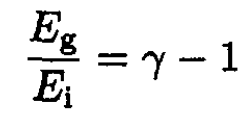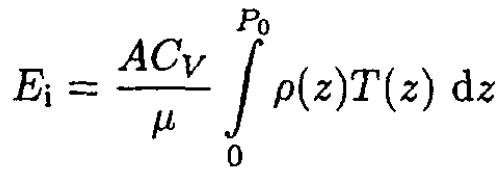
Atmospheric Energy
 المؤلف:
Sidney B. Cahn, Gerald D. Mahan And Boris E. Nadgorny
المؤلف:
Sidney B. Cahn, Gerald D. Mahan And Boris E. Nadgorny
 المصدر:
A GUIDE TO PHYSICS PROBLEMS
المصدر:
A GUIDE TO PHYSICS PROBLEMS
 الجزء والصفحة:
part 2 , p 13
الجزء والصفحة:
part 2 , p 13
 25-8-2016
25-8-2016
 1502
1502
Atmospheric Energy
The density of the Earth’s atmosphere, ρ (z), varies with height z above the Earth’s surface. Assume that the “thickness” of the atmosphere is sufficiently small so that it is in a uniform gravitational field of strength g.
a) Write an equation to determine the atmospheric pressure P (z), given the function ρ (z).
b) In a static atmosphere, each parcel of air has an internal energy ∆Ei and a gravitational potential energy ∆Eg. To a very good approximation, the air in the atmosphere is an ideal gas with constant specific heat. Using this assumption, the result of part (a), and classical thermodynamics, show that the total energy in a vertical column of atmosphere of cross-sectional area A is given by

and that the ratio of energies is

where T is the temperature, P0 is the pressure at the Earth’s surface, μ is the molar mass, Cp is the molar specific heat at constant pressure, and γ ≡ Cp/Cv is the ratio of specific heats.
Hint: The above results do not depend on the specific way in which P(z), T(z) and ρ (z) vary as a function of z (e.g., isothermal, adiabatic, or something intermediate). They depend only on the fact that P(z) is monotonically decreasing. At some step of the derivation, you might find it useful to do an integration by parts.
SOLUTION
a) Again starting with the ideal gas law

we have
 (1)
(1)
b) The gravitational energy of a slice of atmosphere of cross section A and thickness dz at a height z is simply
 (2)
(2)
while the internal energy of the same slice is
 (3)
(3)
The total internal energy Ei is given by the integral of (S.4.21.3):
 (4)
(4)
We wish to change the integral over z into an integral over P. To do so, first consider the forces on the slice of atmosphere:
 (5)
(5)
Rearranging (5), we have
 (6)
(6)
Substituting (6) into (4), we obtain
 (7)
(7)
The total gravitational energy Eg may be found by integrating (2):
 (8)
(8)
Integrating by parts gives
 (9)
(9)
The first term on the RHS of (9) is zero since at the limits of evaluation either z = 0 or ∫ ρ (z') = 0, so we have
 (10)
(10)

The ratio of energies Eg/Ei, from (10) and (7) is
 (11)
(11)
Finally,
 (12)
(12)
 الاكثر قراءة في مواضيع اخرى
الاكثر قراءة في مواضيع اخرى
 اخر الاخبار
اخر الاخبار
اخبار العتبة العباسية المقدسة


